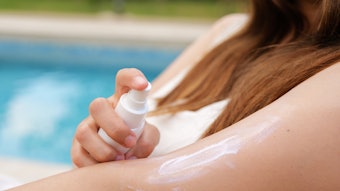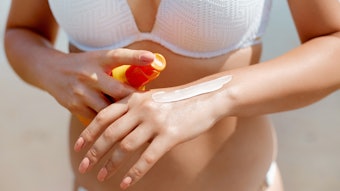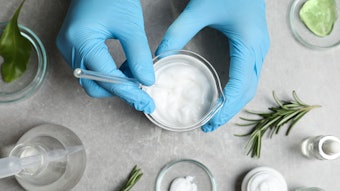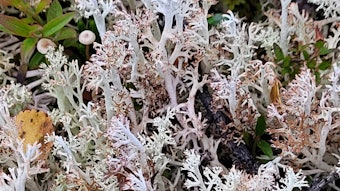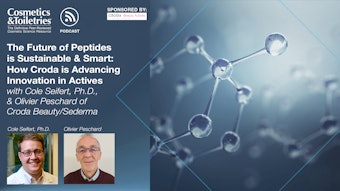Solar radiation such as UVA and UVB induces physiological damage in the skin. Photoaging is a classic example of UV-induced wrinkle formation and thinning of the skin. This phenotype change reflects a deeper impact at the molecular level, in particular on the DNA double helix present in each cell nucleus. The cumulative effect of repeated damage strongly contributes to the development of DNA mutations and down-regulates proteins essential to maintain normal skin turnover.
Prominent among UV-induced lesions on DNA are cyclobutane pyrimidine dimers (CPDs) formed between adjacent pyrimidines on the same DNA strand exposed to UVB (280–320 nm) irradiation19 (Figure 1)Pyrimidine dimers alter the biological function of DNA and are a major cause of lethal,2 transformational3 and tumorigenic4 events induced by UV exposure. UV-induced CPDs may be repaired by enzymatic processes, or by a light-dependent reaction mediated by electron transfer.5 Importantly, the repairing mechanism decreases with aging, contributing to increased mutational risk.6,7
Furthermore, studies in cell lines and in animals have demonstrated a link between DNA damage and erythema formation.8,9 Mediators of inflammation such as NF-kB, IL-6, IL-10 and TNF-α were induced by CPDs,10,11 and the reduction of these inflammatory mediators was stimulated by mechanisms that increase CPD repair.10-12 In vivo studies on animals such as knockout and transgenic mice further proved that when enzymes essential to DNA repair were over-expressed or deleted, a clear correlation with the onset of UV-induced skin erythema was evidenced. 13,14
Studies on the kinetics of CPD removal in humans revealed that the number of CPDs in the epidermis is significantly decreased three days after UV exposure, and CPDs were almost entirely removed 10 days after UV irradiation.15
In order to increase the natural repairing mechanism of the skin, Induchem has previously formulated a DNA-repairing bioactive complexa to boost the natural repairing mechanism of the skin. The repair activity of the complex is due to the presence of a high amount of amino acids such as acetyl tyrosine and proline (see Figure 2).16 Acetyl tyrosine has shown interesting redox properties17 and is a target for phosphorylation of many kinases involved in the DNA repairing mechanism.18 Proline has been shown to be a survival factor in plants and fungi19,20 and also to have redox properties.17 Proline is also a target for protein kinases in the repairing pathway, especially for the so-called proline-directed protein kinases.18 The combination of acetyl tyrosine and proline promotes an increase of the natural repairing mechanism.
The study presented here shows that treatment of reconstituted human skin with the repair complexa (TRC) decreases the formation of UVB-induced CPDs and dramatically reduces UV light-induced erythema in the skin of human volunteers.
Materials and Methods
Ruling out a UV absorbance effect: In order to rule out a possible sunscreen-like effect of TRC, given the aromatic nature of some of the active ingredients, a UV absorbance test was performed; TRC at different concentrations was compared to a UV filter. No UV absorbance on the whole spectrum was observed, while the sunscreen filter fully absorbed the UV light as expected (data not shown). The authors therefore excluded a possible protection effect due to UV absorbance capacity.
Reconstituted human skin model study: The reconstituted human skin modelb was chosen to test the effect of UVB on CPD formation,21 and the influence of treatment with TRC on DNA repair efficacy. Readout was performed by immunohistological staining for CPD-positive cell nuclei and the results were documented by microscopic photography.
TRC was applied on the skin 20 min before UVB irradiation (300 mJ/cm2) in two different concentrations (1% or 3%, diluted in medium). After irradiation the skin models were fixed in 10% formalin solution (0.3 hr later) or incubated with 1% or 3% of TRC for further 5 hr and then fixed. Irradiated but untreated controls were performed in parallel. TRC was present on the skin for the whole experiment to simulate the in vivo condition. The timeline of the experiment on reconstituted human skin is given in Figure 3.
The skin models were fixed in 10% formalin solution at 4°C for at least 24 hr and subsequently embedded in paraffin. Sections of each prepared skin model were cut 4 µm thick and subjected to immunohistochemical detection of CPDs in the epidermal cell nuclei.
Sections were extracted from paraffin by incubation at 65°C for 30 min and immersion in xylene followed by rehydration (immersion in 100%, 90%, 70% ethanol for 2 min each).
After a mild alkaline hydrolysis, sections were dehydrated and incubated with proteinase K at 37°C for 15 min. Incubation with the primary monoclonal antibodyc was performed at 4°C overnight. The primary antibody was washed off with tris-buffered saline (TBS) and sections were treated with the secondary antibody goat antimouse IgG conjugated with a signal enhancer polymer labeled with alkaline phosphatase (AP) moleculesd.
Sections were then incubated in a fuchsin substrate/chromogen solutione for 8 min; color reaction was stopped by rinsing with aqua bidest. AP-fuchsin substrate/chromogen yields a fuchsin red-colored reaction product at the site of the target antigen.
After staining, the sections were microscopically photographed and evaluated by quantitative and qualitative analysis.
Quantification (score) of cyclobutane pyrimidine dimers: The number of stained CPD-positive cells in the cut sections was determined microscopically. For each model, CPDs were counted in five different locations on the section using a 40x objectivef. In addition, the signal intensity of each positive nucleus was rated as strong (score value 3), middle (score value 2) or weak (score value 1), and then the CPDs with each of the score values were counted. Representative areas were also documented by photography with 220x and 880x magnificationg.
Both the number and intensity of the stained nuclei were used to calculate the Total CPD Score of each skin model according to the following expression:
Total CPD Score = 3NS + 2NM + NW
where NS is the number of strong stained nuclei, NM is the number of middle stained nuclei, and NW is the number of weak stained nuclei.
The Total CPD Score of irradiated but untreated skin models directly after irradiation (t0) was set as maximal damage or 100% (all nuclei stained positive, intensive signals).
Because there were two models per treatment (1% and 3% TRC) per time point (0.3 hr and 5 hr), mean values were calculated and standard deviations were given.
Human volunteers study: Twenty-five volunteers were selected and informed about the importance and meaning of the study. Written informed consent was obtained from all the subjects prior to entry into the trial.
The following criteria were used for subject inclusion in the study: clinically healthy and older than 18 years. Criteria for exclusion included skin diseases, pregnancy, uneven skin tone, sunburn, scars or lesions in the test area and Fitzpatrick skin phototype greater than III. The subjects of this study were between 27 and 58 years of age (average: 39.8). They could withdraw from the study at any time without giving any reason. Subjects were instructed not to use any topical preparations on the inner forearms starting from seven days prior to testing and until the end of the test. For cleansing, only water or a mild syndeth was allowed during the entire study, including the run-in phase.
Each volunteer’s inherent reactivity to UV radiation was assessed by a series of UV exposures of varied time intervals given at six spots on the forearm one day prior to the test. Each spot had a diameter of 0.8 cm. The time intervals selected were a geometric series, in which each exposure was 25% greater than the previous exposure. The irradiated sites were assessed 16–24 hr after irradiation and the provisional MED for unprotected skin was determined. The provisional MED was used as indicator from which to determine the exposure times required in the main test.
When this step was complete, the provisional MED (adaptation time: 30 min, room temperature: 21±1°C, relative humidity: 50±5%) had been determined and the required irradiation times had been calculated to achieve a centered final MED.
The next step was induction of erythema and measurement of redness. Three test areas (untreated, placebo, test product) on one of the forearms of each volunteer were delineated with a skin marker. Subsequently, a staff member applied the test cream (Formula 1A) with 3% TRC to one test area and a placebo cream (Formula 1B) to the second test area, while leaving the third area untreated. Each dose was approximately 2 mg/cm²; it was checked for loss by weighing and spread for 40 sec with a presaturated finger cot.
After a waiting period of 20 min, all tested areas were irradiated with UV lightk, adjusted to 125% of MED. Skin redness (representing erythema) was measured 24 and 48 hr after UV irradiation (adaptation time: 30 min; room temperature: 21±1°C; relative humidity: 50± 5%) with a color meterm as a positive change on the green-red (a*) axis of a three-dimensional color coordinate system.
Before each measuring series, the instrument was calibrated against the standard white tile. Measurements were performed according to the guidelines of the Standardization Group of the European Society of Contact Dermatitis.22
Data were analyzed using the Student’s t-test. The timeline of the experiment on human volunteers is given in Figure 4.
Results
As shown in Figure 5, pretreatment of reconstituted human skin for 20 min with TRC at 3% before UVB irradiation followed by 5 hr of further incubation with TRC significantly reduces both the number and intensity of CPDs. This is particularly evident in the skin’s basal layer (see arrows). CPD quantitative scoring (Figure 6) shows that at all time points from UVB irradiation the skin treated with TRC at 1% and 3% has significantly less DNA damage, and therefore a better repair rate, when compared to irradiated but untreated control. This difference reached 50% at 5 hr with 3% TRC treatment and was statistically significant (p < 0.05, Student’s t-test). These results confirm previously published effects of TRC on the same model when applied after UVB irradiation.16
In human volunteers, pretreatment of inner forearm skin for 20 min with a cream containing TRC at 3% significantly (p < 0.001, Student’s t-test) reduced the parameter a* (erythema index), measured quantitatively by color meter (Figure 7). This decrease was observed after 24 hr and 48 hr from UV light irradiation and was –36.8% and –51.6%, respectively, when compared to the treatment with the placebo cream. The data represented an average from 25 volunteers.
Discussion and Conclusion
The repair complexa (TRC) discussed in this article has been shown to decrease the damaging effect of UV solar radiation both in a reconstituted skin model and in vivo on the inner side of the arm of human volunteers. It accelerated the removal of CPDs in the reconstituted skin model and it drastically reduced erythema formation on the arm of human volunteers.
Although this set of experiments did not prove a direct link between CPDs formation and erythema development, several published papers10–14 suggest a strong association between DNA damage repair and erythema formation, concluding that protection or repair from UV-induced DNA damage would inhibit or reduce skin erythema development. Based on these observations the current authors believe that the erythema reduction that occurred on human volunteers after pretreatment with TRC followed by UV irradiation is due to the capacity of TRC to accelerate repair of CPDs and therefore to reduce DNA damage and the consequent triggering of the inflammation reaction. Further study of CPDs in vivo would be needed to fully demonstrate this hypothesis.
The repairing nature of TRC is also supported by previous studies in human reconstituted skin where the complex was applied 5 hr after UVB exposure and showed the same pattern of efficacy, i.e., an increased removal of CPDs when compared to control.16
Skin pretreatment of human volunteers with TRC before UV exposure was chosen instead of an aftertreatment. This decision was based on the longest time of compound absorbance by the skin in vivo compared to the human reconstituted skin model where the absorbance is faster.23 Therefore, the compound was allowed more time in vivo to penetrate the skin in order to fully perform its repairing function.
Based on these results, one can conclude that TRC is strongly suggested when developing products that fight UV-induced DNA damage and products formulated to reduce or prevent erythema (sunburn) after sun exposure.
The usefulness of TRC is further highlighted by recent interest in products that would help the skin respond to the deleterious effect of UV light by increasing the mechanisms that help to repair damage at the molecular level, such as oxidation of DNA, protein and lipids. The combination of TRC with sunscreen filters in a formulation would assure a better protection from the effect of UV-induced oxidation.
It is possible, in fact, that sunscreen products would not assure a complete screening of UV, especially when final SPF is not elevated, typically in day creams. The authors have recently demonstrated that an SPF 20 cream is not able to avoid UV-induced down regulation of oxidation repairing enzymes (data not published yet), demonstrating a “leaking” of protection by UV sunscreens.
In these situations, products like TRC would help the skin to react to UV light not screened by the filter. In the future, further products to help repair or protect oxidized protein and lipids would ideally complement TRC to ensure a better skin reaction to UV light. Some of these products are in current development at Induchem and will be presented shortly.
Finally TRC has proven to be compatible and easy to formulate in various cosmetics forms, being water-soluble and stable at pH values ranging from 4 to 8. Moreover, skin patch tests (TRC 10%) and repeated insult patch tests (RIPT) in human volunteers have proved the safety profile of TRC (data not shown).
The authors conclude that TRC could be used as a pretreatment or an aftertreatment in day products to act immediately against UV-induced skin oxidation and in night products to help recovery and repair.
References
1. RB Setlow, Cyclobutane-type pyrimidine dimers in polynucleotides, Science 153(734) 379–386 (1966)
2. H Harm, Repair of UV-irradiated biological systems: photoreactivation, In Photochemistry and Photobiology of Nucleic Acids, vol 2, SY Yang, ed, New York, NY: Academic Press 219–262 (1976)
3. BM Sutherland, NC Delihas, RP Oliver and JC Sutherland, Action spectra for ultraviolet light-induced transformation of human cells to anchorage-independent growth, Cancer Res 41(6) 2211–2214 (1981)
4. R Hart, RB Setlow and AD Woodhead, Evidence that pyrimidine dimers in DNA can give rise to tumors, Proc Natl Acad Sci USA 74(12) 5574–5578 (1977)
5. L Roza L, FR de Gruijl, JB Bergen Henegouwen, K Guikers, H van Weelden, GP van der Schans and RA Baan, Detection of photorepair of UV-induced thymine dimers in human epidermis by immunofluorescence microscopy, J Invest Dermatol 96(6) 903–907 (1991)
6. Y Takahashi, S Moriwaki, Y Sugiyama, Y Endo, K Yamazaki, T Mori, M Takigawa and S Inoue, Decreased gene expression responsible for post-ultraviolet DNA repair synthesis in aging: a possible mechanism of age-related reduction in DNA repair capacity, J Invest Dermatol 124(2) 435–442 (2005)
7. M Yamada, MU Udono, M Hori, R Hirose, S Sato, T Mori and O Nikaido, Aged human skin removes UVB-induced pyrimidine dimers from the epidermis more slowly than younger adult skin in vivo, Arch Dermatol Res 297(7) 294–302 (2006)
8. AA Vink and L Roza, Biological consequences of cyclobutane pyrimidine dimers, J Photochem Photobiol B 65(2–3) 101–104 (2001)
9. DB Yarosh, DNA repair, immunosuppression and skin cancer, Cutis 74(5 Suppl) 10–13 (2004)
10. C Petit-Frère, PH Clingen, M Grewe, J Krutmann, L Roza, CF Arlett and MHL Green, Induction of interleukin-6 production by ultraviolet radiation in normal human epidermal keratinocytes and in a human keratinocyte cell line is mediated by DNA damage, J Invest Dermatol 111(3) 354–359 (1998)
11. P Wolf, H Maier, RR Mullegger, CA Chadwick, R Hofmann-Wellenhof, HP Soyer, A Hofer, J Smolle, M Horn, L Cerroni, D Yarosh, J Klein, C Bucana, K Dunner Jr, CS Potten, H Honigsmann, H Kerl and ML Kripke, Topical treatment with liposomes containing T4 endonuclease V protects human skin in vivo from ultraviolet-induced upregulation of interleukin-10 and tumor necrosis factor-α, J Invest Dermatol 114(1) 149–156 (2000)
12. H Stege, L Roza, AA Vink, M Grewe, T Ruzicka, S Grether-Beck and J Krutmann, Enzyme plus light therapy to repair DNA damage in ultraviolet-B-irradiated human skin, Proc Natl Acad Sci USA 97(4) 1790–1795 (2000)
13. W Schul, J Jans, YMA Rijksen, KHM Klemann, APM Eker, Jan de Wit, O Nikaido, S Nakajima, A Yasui, JHJ Hoeijmakers and GTJ van der Horst, Enhanced repair of cyclobutane pyrimidine dimers and improved UV resistance in photolyase transgenic mice, Embo J 21(17) 4719–4729 (2002)
14. RJW Berg, HJT Ruven, AT Sands, FR de Gruijl and LHF Mullenders, Defective global genome repair in XPC mice is associated to skin cancer susceptibility but not with sensitivity to UVB induced erythema and edema, J Invest Dermatol 110(4) 405–409 (1998)
15. SK Katiyar, MS Matsui, and H Mukhtar, Kinetics of UV light-induced cyclobutane pyrimidine dimers in human skin in vivo: an immunohistochemical analysis of both epidermis and dermis, Photochem Photobiol 72(6) 788–793 (2000)
16. K Schweikert, W McGregor, C Klein and G Dell’Acqua, Amino acids to increase DNA repair after UVB irradiation of reconstituted human skin, SOFW J 132(11) 22–26 (2006)
17. JR Milligan, JA Aguilera, A Ly, NQ Tran, O Hoang and JF Ward, Repair of oxidative DNA damage by amino acids, Nucleic Acids Res 31(21) 6258–6263 (2003)
18. K Bender, C Blattner, A Knebel, M Iordanov, P Herrlich and HJ Rahmsdorf, UV-induced signal transduction, J Photochem Photobiol B 37(1–2) 1–17 (1997)
19. C Chen and MB Dickman, Proline suppresses apoptosis in the fungal pathogen Colletotrichum trifolii, Proc Natl Acad Sci USA 102(9) 3459–3464 (2005)
20. PP Saradhi, S Alia Arora and KVSK Prasad, Proline accumulates in plants exposed to UV radiation and protects them against UV induced peroxidation, Biochem Biophys Res Commun 209(1) 1–5 (1995)
21. JP Therrien, M Rouabhia, EA Drobetsky and R Drouin, The multilayered organization of engineered human skin does not influence the formation of sunlight-induced cyclobutane pyrimidine dimers in cellular DNA, Cancer Res 59(2) 285–289 (1999)
22. A Fullerton, T Fisher, A Lahti, KP Wilhelm, H Takiwaki and J Serup, Guidelines for measurement of skin colour and erythema. A report from the standardization group of the European Society of Contact Dermatitis, Contact Derm 35(1) 1–10 (1996)
23. FP Schmook, JG Meingassner and A Billich, Comparison of human skin or epidermis models with human and animal skin in in vitro percutaneous absorption, Int J Pharm 215(1–2) 51–56 (2001)
